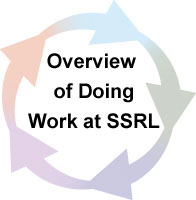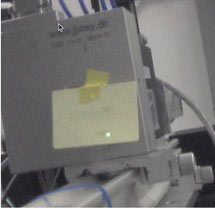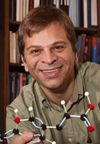__________________________________________________________________________
SSRL Headlines
Vol. 9, No. 10 April, 2009
__________________________________________________________________________
Contents of this Issue:
__________________________________________________________________________
1.
User Safety Update
(contacts: J. Stohr, stohr@slac.stanford.edu; B. Bozorg-Chami,
bchami@slac.stanford.edu; M. Padilla, mpadilla@slac.stanford.edu)
We take very seriously the challenges of safety at SSRL. We want to remind
everyone who uses SSRL facilities that you share in the responsibility of
ensuring a safe workplace. That includes planning experiments properly, taking
extra efforts in identifying related hazards, and working closely with us to
develop mitigations and controls.
http://www-ssrl.slac.stanford.edu/userresources/esh.html
We recently issued a user safety advisory regarding an injury caused when a
glass, crimp-top vial used to transport air sensitive solutions under liquid
nitrogen burst while it was being warmed to room temperature. This incident
identified a significant safety issue with these types of sample containers.
This incident is currently being investigated; the results and lessons learned
will be shared shortly.
http://www-ssrl.slac.stanford.edu/safety/advisory/useradvisory_4-09.html
As a final note, immediately report any unsafe work practices or safety
concerns to the SSRL Duty Operator, Safety Officers and/or staff to continue to
make SSRL a safe workplace.
http://www-ssrl.slac.stanford.edu/safety/

PSD/SSRL ES&H
Coordinator:
Behzad
Bozorg-Chami |
|

SSRL ES&H Coordinator:
Matthew
Padilla |
|
 Overview Overview |
2.
Caution Advised Regarding Swine Flu Outbreak
The World Health Organization and U.S. Centers for Disease Control have
reported 40 confirmed cases of swine flu in the U.S. with no fatalities. Most
cases occurred in New York, all within one school. As of yesterday, seven had
been reported in Southern California, with one in Northern California
(Sacramento). No Stanford faculty, staff or students had reported symptoms of
concern. Stanford officials are advising students, faculty and staff to avoid
travel to Mexico.
As a precaution in case the flu should spread in the United States, Secretary
of Homeland Security Janet Napolitano declared a public health emergency to
allow the release of funds in case a public health response is needed.
Influenza is thought to spread mainly person-to-person through coughing or
sneezing of infected people.
The CDC provides some simple tips for staying healthy during any flu season:
-
Cover your nose and mouth with a tissue when you cough or sneeze.
Throw the tissue in the trash after you use it.
-
Wash your hands often with soap and hot water, especially after you cough
or sneeze. Alcohol-based hands cleaners may also be effective
-
Avoid touching your eyes, nose or mouth. The virus spreads that way.
-
Try to avoid close contact with sick people.
-
If you feel unwell, stay home from work or school and limit contact
with others to keep from infecting them.
Stanford University is closely monitoring developments in the international
outbreak of Swine Influenza. For information and updates see "Information About
Pandemic Influenza".
See also the university's Emergency
Information page. Additional recommendations and information are
available on the World Health Organization and
U.S. Centers for Disease Control Web sites.
At SLAC you can also contact SLAC Medical at ext. 2281.
3. Science Highlight —
Novel Mechanism for DNA Biosynthesis in Organisms with
Gene thyX could Lead to Better Antibiotics
(contacts: I. Mathews, iimathew@slac.stanford.edu; A. Kohen,
amnon-kohen@uiowa.edu)
|  |
Before DNA is made, the subunits composing DNA must be made. The essential
process of making one of these subunits, thymidine monophosphate (TMP), was
thought to be similar for most living things, but scientists recently
discovered that some bacteria and viruses use a different type of enzyme to
perform this reaction. The discovery might result in new antibiotics that would
be effective against human pathogens, but not affect human cells.
The research group led by Prof. Amnon Kohen of the University of Iowa analyzed
the reactions of the enzyme called flavin-dependent thymidylate synthase
(FDTS), used by some pathogenic bacteria, to turn dexoyuridine monophosphate
(dUMP) into TMP. The mechanism they propose is not only different than the
mechanism used by thymidylate synthase in eukaryotes including humans, it also
has novel properties that had not previously been seen in biological systems.
The proposed mechanism is based on chemical and structural analysis of the FDTS
enzyme. Kohen's group performed crucial chemical analysis of the enzyme and
reaction, including labeled isotopic substitution and a form of mass
spectrometry. To determine the molecular structure, Kohen's group provided
purified material to Irimpan Mathews of SSRL, who crystallized and solved the
structures of selected mutant FDTS enzymes. Structural data provided a detailed
description of the active site of the enzyme. They collected x-ray diffraction
data at SSRL's Beam Line 9-2.
Drugs designed to target the FDTS enzyme could provide treatments for various
diseases including anthrax, tuberculosis, botulism, syphilis, pneumonia, and
Lyme disease. Multiple drug resistant bacteria are likely to be susceptible to
such agents, since the antibiotics currently in use do not target FDTS. This
work was published in the April 16 issue of Nature.
To learn more about this research see the full scientific highlight at:
http://www-ssrl.slac.stanford.edu/research/highlights_archive/thyx_gene.html
4. Science Highlight —
Finding the Crystal Structure of P-gp: A Protein that
Makes Cancer Cells Resistant to Chemotherapy
(contact: G. Chang, gchang@scripps.edu)
|  |
Medications can be rendered ineffective through cells developing multidrug
resistance. This is the case in many forms of cancer cells that fail to respond
to chemotherapy. The ability of these cells to avoid the effects of drugs can
be due to the actions of P-glycoprotein (P-gp). This protein sits in the
membranes of cells and acts like a pump. It ushers a wide range of potentially
harmful molecules from inside the membrane to outside the cell. Unfortunately,
it can also mediate the removal of life-saving medications.
The mechanism behind the ability of P-gp to act upon such a diverse range of
chemicals has been a mystery. The recent crystal structure of P-gp sheds light
on its mechanism and brings scientists a step closer to developing ways to
prevent P-gp from banishing medicines from cells.
A research team led by Prof. Geoffrey Chang of The Scripps Research Institute
used SSRL Beam Lines 9-2 and 11-1 to collect part of the x-ray diffraction data
used to solve the structure of mouse P-gp. In the crystal, the protein looks
like a "V" with bulbous ends. The scientists believe that they caught P-gp in
the pre-transport state, where the protein is ready to bind a target molecule.
The open arms of the "V" extend through the membrane into the cytoplasm and the
closed point of the "V" extends outside the cell.
P-gp likely works by binding a molecule in a central cavity and closing its
open arms to create a cage. It then opens the other ends of the arms to reverse
the "V", depositing the trapped molecule outside the cell. While both the
bacterial and the mouse versions of the molecule have many hydrophobic
side-chains lining their cavities, the mouse P-gp has many more aromatics.
These sticky residues could bind to a variety of organic molecules, which may
explain P-gp's ability to target a wide range of molecules.
Understanding how medicinal molecules bind to P-gp will enable researchers to
redesign existing drugs to avoid falling into this trap and thus be more likely
to retain their potency. This work was published in the March 27 issue of the
journal Science.
To learn more about this research see the full scientific highlight at:
http://www-ssrl.slac.stanford.edu/research/highlights_archive/p-gp.html
5. Science Highlight —
A New Way to Limit Damaging Production of Nitric Oxide
(contacts: E. Garcin, egarcin@umbc.edu; E.D. Getzoff, edg@scripps.edu)
|  |
Nitric oxide (NO) is one of very few gaseous signaling molecules in humans. NO
causes smooth muscles to relax and blood vessels to open. Its deficiency leads
to disorders such as hypertension and impotence, but too much NO can lead to
rheumatoid arthritis, stroke, cancer, and other diseases. Three distinct but
related enzymes (called nitric oxide synthases) make NO from an arginine
molecule. One of the nitric oxide synthases, iNOS, creates localized, high
concentrations of NO as part of the body's immune response. Because it is this
elevated activity of iNOS that can cause disease, scientists would like to
specifically inhibit the action of iNOS without interfering with the activity
of the other two enzymes, eNOS and nNOS. Since the three enzymes have identical
active sites (i.e. where NO is made), finding an inhibitor that will bind in
this site for iNOS but not eNOS nor nNOS has proved challenging.
Crystal structures by a research group led by Prof. Elizabeth Getzoff of The
Scripps Research Institute have revealed a mechanism that allows selective
inhibition of iNOS. Using data partially collected at SSRL Beam Lines 7-1, 9-1,
and 9-2, the group solved 17 structures of NOS enzymes bound to a variety of
inhibitors.
Some of the inhibitors, as seen in the crystal structures, had a surprising
effect on iNOS. These inhibitors bound loosely in the arginine binding area of
the enzyme's active site and caused a chain reaction of structural changes.
This resulted in an additional binding site opening far away from the active
site. Only those inhibitor molecules that have a tail that could reach and bind
in this additional site effectively inhibited iNOS but not eNOS. While the
inhibitors could similarly bind at the active sites, the eNOS enzyme did not
open an additional binding site for the inhibitors' tail.
Uncovering this new binding mechanism informs the future design of drugs that
specifically inhibit iNOS activity. Inhibitors can have a region that binds
loosely in the active site and a tail that swings around to bind in a distant,
and distinct, secondary site created by the active site interactions. The
researchers have called this an anchored plasticity approach and suggest that
it may be useful for designing selective inhibitors for other enzymes that are
difficult to target due to their similarities to other enzymes. This work was
published in the November 2008 issue of Nature Chemical Biology.
To learn more about this research see the full scientific highlight at:
http://www-ssrl.slac.stanford.edu/research/highlights_archive/No_inhibitor.html
6.
From the Director of the Stanford Synchrotron Radiation Lightsource:
Timeless SSRL
April 3, 2009 SLAC Today Article by Jo Stöhr
|
 |
In my last SLAC Today column, I wrote about the history of the Stanford
Synchrotron Radiation Laboratory and how it fits into the bigger model of "one
lab." In the meantime, SSRL changed its name from "Laboratory," which now
appears in the SLAC name, to the more appropriate "Lightsource." Today I want
to update you on how this 35-plus-year-old lightsource manages to keep up with
the best in the world. No doubt, SSRL has stiff competition: the Web site
lightsources.org now lists nearly 70 lightsources worldwide. Here is the story
of how through the years SSRL has kept its place in the elite club of
facilities that can count themselves as "top notch" in terms of brilliant
x-rays, number of users and scientific achievements.
In terms of spectral brightness, a metric that best characterizes the quality
of an x-ray source, SSRL's SPEAR3 is an excellent source; yet newer ones just
commissioned or under construction have edged ahead with time. Fortunately,
however, source brightness is only part of the story in lightsource quality.
Given that the performance of our source is sufficiently close to the best,
other factors can move us ahead on the path to scientific excellence. The
secret of SSRL's success has been to squeeze the most out of what is there.
Tight operations budgets and understaffing, especially over the last two years,
have been overcome by the ability of SSRL staff to tighten their belts, stretch
their responsibilities and go the extra mile in support of the user program.
Another factor is the quality of the SSRL scientific staff, which always
receives special mention during external reviews. Many of our scientists carry
out their own scientific programs, performing experiments not only at SSRL but
if needed also at other synchrotron radiation facilities. In the end, they
bring back to SSRL what they have seen and learned, and this is incorporated
into the SSRL program. Read more in the full SLAC
Today article.
7.
First Light Achieved on Beam Line 14-1
 |
Light was successfully introduced into the experimental hutch of the newest
SSRL beam line the morning of Wednesday, April 8. BL14-1 is a macromolecular
crystallography branch line mostly funded by Genentech and the Joint Center for
Structural Genomics (through funding from National Institutes of Health's
National Institute of General Medical Sciences' Protein Structure Initiative).
Building beam lines is a complex endeavor involving many groups at SSRL and
SLAC. Daniel Harrington, who served as project manager for construction of this
beam line, sent a message to staff acknowledging the contributions of a long
list of individuals in virtually every group at SSRL without whose commitment
and hard work this project would not have gone so smoothly.
see also: http://today.slac.stanford.edu/feature/2009/ssrl-beamline14.asp
8.
SSRL X-ray/VUV Proposals due June 1
(contact: (contact: C. Knotts, knotts@slac.stanford.edu)
In response to user requests, we have increased the frequency of calls for
proposals to conduct X-ray/VUV experiments at SSRL. New proposals can now be
submitted June 1, September 1, or December 1. In addition, we eliminated the
distinction between single experiment and program proposals, so that we have
just one type of standard proposal valid for two years. For more information
on proposal deadlines, instructions, and forms see:
http://www-ssrl.slac.stanford.edu/userresources/xray_vuv_proposal_guide.html
9.
Photon Science Faculty Members Awarded Endowed Chairs
(contact: B.
Hedman, hedman@slac.stanford.edu)

| |  |
|
Todd Martinez | |
Phil Bucksbaum
|
As announced by Stanford University, two members of the Photon Science Faculty
have been awarded Endowed Chairs, effective April 14, 2009 Todd Martinez now
holds the "David Mulvane Ehrsam and Edward Curtis Franklin Professorship in
Chemistry" and Philip Bucksbaum the "Marguerite Blake Wilbur Professorship in
Natural Science".
http://home.slac.stanford.edu/photonScienceFaculty.html
10.
New Era of Research Begins as World's First Hard X-ray Laser Achieves
"First Light"
April 21, 2009 SLAC National Accelerator Laboratory Press Release
|
 |
The world's brightest x-ray source sprang to life last week at the U.S.
Department of Energy's SLAC National Accelerator Laboratory. The Linac Coherent
Light Source (LCLS) offers researchers the first-ever glimpse of high-energy or
"hard" x-ray laser light produced in a laboratory.
When fine tuning is complete, the LCLS will provide the world's brightest,
shortest pulses of laser x-rays for scientific study. It will give scientists
an unprecedented tool for studying and understanding the arrangement of atoms
in materials such as metals, semiconductors, ceramics, polymers, catalysts,
plastics, and biological molecules, with wide-ranging impact on advanced energy
research and other fields.
"This milestone establishes proof-of-concept for this incredible machine, the
first of its kind," said SLAC Director Persis Drell. "The LCLS team overcame
unprecedented technical challenges to make this happen, and their work will
enable frontier research in a host of fields. For some disciplines, this tool
will be as important to the future as the microscope has been to the past."
Even in these initial stages of operation, the LCLS x-ray beam is brighter than
any other human-made source of short-pulse, hard x-rays. Initial tests produced
laser light with a wavelength of 1.5 Angstroms, or 0.15 nanometers-the
shortest-wavelength, highest-energy x-rays ever created by any laser. To
generate that light, the team had to align the electron beam with extreme
precision. The beam cannot deviate from a straight line by more than about 5
micrometers per 5 meters-an astounding feat of engineering. Read more in the
full press
release
11.
LCLS User Research Administration Update
|
 |
We are pleased to announce that we have filled the position of LCLS User
Research Administrator Manager. Henia Kamil, formerly Manager of Academic
Programs at the University of Michigan College of Engineering, joined us in
March. Henia will be part of the User Research Administration team, with
functional responsibilities to the LCLS Experimental Facilities Division.
Earlier this month, Henia distributed the very first LCLS user newsletter, and
she is already working on the next issue. With LCLS construction wrapping up,
commissioning activities ramping up, milestones being reached, and preparations
underway for the first user experiments at the LCLS later this summer, this is
an extremely exciting time. So, stay tuned for more LCLS user news in the
coming weeks and months. If you would like to join the mailing list to receive
future LCLS user newsletters, contact Henia Kamil, hekamil@slac.stanford.edu.
12.
LCLS Proposals for AMO and SXR Instruments due May 15, 2009
(contact: H. Kamil,
hekamil@slac.stanford.edu)
The Linac Coherent Light Source is quickly approaching completion, with first
laser light anticipated this summer. With construction on the Atomic, Molecular
and Optical science instrument and Soft X-Ray beam line underway, the LCLS team
has released a second call for scientific proposals. Researchers are invited to
submit proposals for experiments to be conducted between March and July 2010 on
these two experimental stations. Proposals must be submitted by May 15, 2009.
More information about the call for proposals and detailed descriptions of the
instruments are available on the LCLS Web site. Specific questions about the
AMO science instrument should be directed to John Bozek
(jdbozek@slac.stanford.edu) and about the SXR beam line to Michael Rowen
(rowen@slac.stanford.edu).
For proposal submission see: http://lcls.slac.stanford.edu/user/
13.
Photon Science-Related Workshops, Conferences and Schools
__________________________________________________________________________
SSRL Headlines is published electronically monthly to inform SSRL users,
sponsors and other interested people about happenings at SSRL. SSRL is a
national synchrotron user facility operated by Stanford University for the
U.S. Department of Energy Office of Basic Energy
Sciences. Additional support for
the structural biology program is provided by
the DOE
Office of Biological and Environmental Research, the NIH
National Center for Research Resources and the NIH Institute for General Medical
Sciences. Additional information about
SSRL and its operation and schedules is available from the SSRL WWW
site.
__________________________________________________________________________
To leave the SSRL-HEADLINES distribution, send email as shown below:
To: LISTSERV@SSRL.SLAC.STANFORD.EDU
Subject: (blank, or anything you like)
The message body should read
SIGNOFF SSRL-HEADLINES
That's all it takes. (If we have an old email address for you that is
forwarded to your current address, the system may not recognize who
should be unsubscribed. In that case please write to
ssrl-headlines-request@ssrl.slac.stanford.edu and we'll try to figure out
who you are so that you can be unsubscribed.)
If a colleague would like to subscribe to the list, he or she should send
To: LISTSERV@SSRL.SLAC.STANFORD.EDU and use the message body
SUBSCRIBE SSRL-HEADLINES
|












